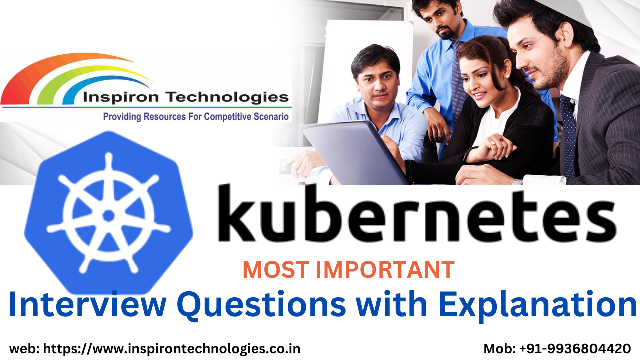Kubernetes Interview Questions

Kubernetes is an open-source container orchestration platform that automates the deployment, scaling, and management of containerized applications. It helps in automating manual tasks, ensuring high availability, and scaling applications easily.Most Important Kubernetes Interview Questions with Answer
1. What is Kubernetes, and what problems does it solve?
2. What are the key components of Kubernetes architecture?
Kubernetes has several key components, including the Master components (API server, etcd, scheduler, controller manager) and Node components (kubelet, container runtime, kube-proxy).
3. How does Kubernetes manage containerized applications' scaling and self-healing capabilities?
Kubernetes uses ReplicaSets (or Deployments) to manage scaling, ensuring the desired number of replicas. For self-healing, Kubernetes continuously monitors the health of pods and restarts or reschedules them if they fail.
4. What is a Pod in Kubernetes?
A Pod is the smallest deployable unit in Kubernetes, representing one or more containers sharing the same network namespace and storage volumes. Containers within a Pod can communicate via localhost, and they are scheduled and scaled together.
5. Explain the role of Kubernetes Services.
Kubernetes Services provide stable network endpoints to access pods. They enable load balancing across pods and abstract the network details, allowing pods to be replaced or relocated without affecting the service.
6. What is a Kubernetes Deployment?
A Kubernetes Deployment is a higher-level abstraction that manages ReplicaSets. It allows you to declaratively define desired state, rolling updates, and rollbacks for your application.
7. How can you pass configuration data to a Kubernetes Pod?
Configuration data can be passed to a Pod using environment variables, ConfigMaps, or Secrets.
8. What are ConfigMaps in Kubernetes?
ConfigMaps are Kubernetes objects used to store configuration data in key-value pairs. They can be used to inject configuration into a Pod's containers.
9. How do Secrets differ from ConfigMaps?
Secrets are similar to ConfigMaps but are designed to store sensitive data like passwords, API keys, and tokens in an encrypted format.
10. How can you secure communication between different components in Kubernetes?
Communication between components can be secured using Transport Layer Security (TLS) certificates and enabling authentication and authorization mechanisms.
11. What is a Kubernetes Namespace, and why is it used?
A Kubernetes Namespace is a logical partitioning mechanism used to isolate resources and avoid naming collisions. It helps in organizing and managing the cluster resources more effectively.
12. Explain Kubernetes Persistent Volumes (PV) and Persistent Volume Claims (PVC).
Persistent Volumes (PV) are cluster-wide storage volumes that exist independently of pods. Persistent Volume Claims (PVC) are requests made by pods for storage resources, and Kubernetes binds them to available Persistent Volumes.
13. How does Kubernetes handle batch processing jobs?
Kubernetes provides a resource called Jobs, which allows you to run batch processes to completion and ensures the desired number of completions before terminating.
14. Describe the difference between a StatefulSet and a Deployment.
A StatefulSet is used for stateful applications that require stable, unique network identities and stable persistent storage. It maintains a sticky identity for each pod. In contrast, a Deployment is used for stateless applications.
15. What is the purpose of readiness probes and liveness probes in Kubernetes?
Readiness probes are used to determine when a pod is ready to receive traffic. Liveness probes are used to check the health of a pod and restart it if it's in a bad state.
16. How can you roll back a failed deployment in Kubernetes?
You can roll back a deployment using the
kubectl rollout undo command or by specifying the previous revision number.
17. What is the Horizontal Pod Autoscaler (HPA) in Kubernetes?
The Horizontal Pod Autoscaler automatically scales the number of replicas of a replication controller, deployment, or replica set based on observed CPU utilization or other custom metrics.
18. How do you perform rolling updates in Kubernetes?
Kubernetes performs rolling updates by creating a new ReplicaSet with the updated configuration and gradually replacing old pods with new ones.
19. What are DaemonSets in Kubernetes, and what are they used for?
DaemonSets ensure that all or some nodes in the cluster run a copy of a specific pod. They are often used for monitoring agents, log collectors, etc.
20. How can you run a one-time task in Kubernetes?
You can use Kubernetes Jobs to run one-time tasks to completion, without the need for manual intervention.
21. What is the purpose of the
kubectl command-line tool?
kubectl is used to interact with Kubernetes clusters, allowing you to create, manage, and monitor Kubernetes resources.
22. How does Kubernetes handle node failures?
Kubernetes detects node failures through the
kubelet on each node. When a node fails, the affected pods are rescheduled onto healthy nodes.
23. Explain the concept of Ingress in Kubernetes.
Ingress is an API object used to manage external access to services within a cluster. It allows you to define routing rules and SSL/TLS termination for incoming traffic.
24. How can you perform a dry-run for a Kubernetes resource before actually applying it?
The
kubectl apply --dry-run=client command allows you to preview the changes that would be made without actually applying them.
25. What is Kubernetes Helm, and how is it beneficial?
Helm is a package manager for Kubernetes, allowing you to define, install, and upgrade complex Kubernetes applications with ease using Helm Charts.
26. What is a Kubernetes Operator, and how does it differ from built-in controllers like Deployments?
A Kubernetes Operator is a method of packaging, deploying, and managing a Kubernetes application using custom resources and controllers. It extends the capabilities of built-in controllers and enables you to define complex application-specific behavior.
27. Explain the differences between a Deployment and a StatefulSet.
Deployments are suitable for stateless applications, providing easy scaling and rolling updates. StatefulSets are used for stateful applications that require unique identities, stable storage, and ordered deployment.
28. How does Kubernetes manage resource allocation and scheduling decisions for pods?
Kubernetes uses the resource requests and limits specified in a pod's configuration to make scheduling decisions and allocate resources on nodes accordingly.
29. What are Taints and Tolerations in Kubernetes, and how are they used?
Taints are applied to nodes to repel pods, while Tolerations are applied to pods to tolerate specific taints. They are used together to control which pods can be scheduled on which nodes.
30. How do you horizontally scale a StatefulSet in Kubernetes?
Horizontal scaling for StatefulSets is done using the Horizontal Pod Autoscaler (HPA), which automatically adjusts the number of replicas based on resource utilization.
31. Explain the role of kube-proxy in Kubernetes.
kube-proxy is a network proxy that runs on each node, responsible for forwarding traffic to the appropriate pods. It also provides load balancing for services.
32. What are Network Policies in Kubernetes, and why are they important?
Network Policies are Kubernetes resources used to control the network traffic flow between pods. They are crucial for enforcing security rules and isolating applications.
33. How can you handle application configuration that requires frequent updates in Kubernetes?
Dynamic configuration can be managed using ConfigMaps or Secrets, and applications can use the Kubernetes API to watch for changes and update themselves accordingly.
34. What is the Kubernetes Control Plane, and what components does it consist of?
The Kubernetes Control Plane is responsible for managing the cluster's overall state. Its components include the API server, etcd, kube-scheduler, and kube-controller-manager.
35. How do you configure DNS for Kubernetes services?
Kubernetes assigns DNS names to services based on their names and namespaces, allowing other pods in the cluster to access services using DNS.
36. How does the Pod-to-Pod communication work within a Kubernetes cluster?
Pods communicate with each other using their individual IP addresses, and they can refer to other pods using their DNS names.
37. What are the different types of volumes supported in Kubernetes, and when would you use each type?
Kubernetes supports various volume types, such as hostPath, emptyDir, persistentVolumeClaim, etc. You would use each type based on your specific use case and storage requirements.
38. Explain the concept of a Sidecar container in Kubernetes.
A Sidecar container is an additional container that runs in the same pod as the main application container. It provides supplementary functionality, such as logging, monitoring, or data preprocessing.
39. What is the purpose of the Downward API in Kubernetes?
The Downward API allows you to expose pod and container information (e.g., labels, annotations, resource limits) as environment variables or volumes for use in other containers or applications.
40. How do you set up and manage multi-container pods in Kubernetes?
You can define multi-container pods in the same YAML file, sharing the same network namespace and volumes. Ensure the containers are designed to work together and follow best practices for communication and coordination.
We hope that you must have found this exercise quite useful. If you wish to join online courses on Networking Concepts, Machine Learning, Angular JS, Node JS, Flutter, Cyber Security, Core Java and Advance Java, Power BI, Tableau, AI, IOT, Android, Core PHP, Laravel Framework, Core Java, Advance Java, Spring Boot Framework, Struts Framework training, feel free to contact us at +91-9936804420 or email us at aditya.inspiron@gmail.com.
Happy Learning
Team Inspiron Technologies

Leave a comment